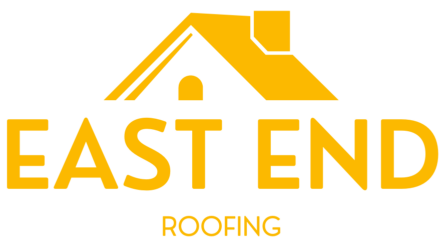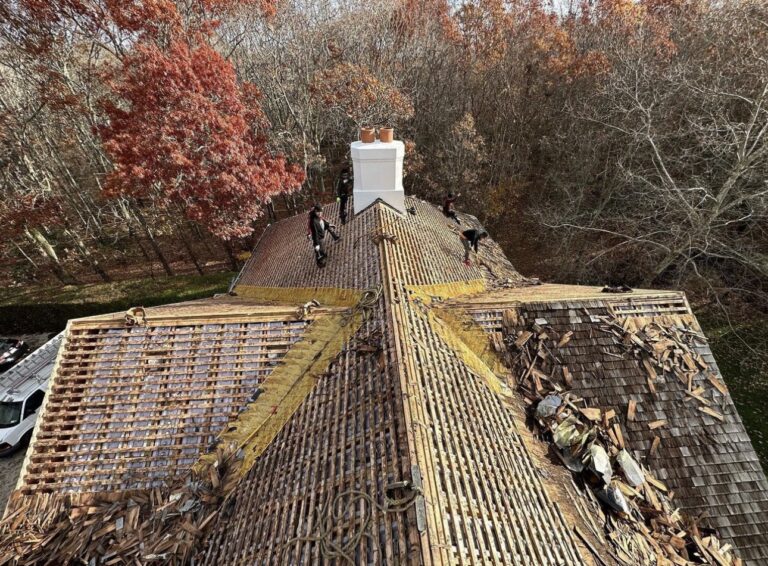Roof leaks can be one of the most problematic issues for homeowners in East Hampton, often leading to extensive damage if left undetected. Knowing how to spot roof leaks early in East Hampton can save you both time and money, preventing unnecessary repairs and keeping your home in good condition. The earlier you catch a leak, the less damage it will do to your roof and home’s structure. In this guide, we’ll discuss the key signs of roof leaks and provide some helpful tips on how to inspect your roof for potential issues.
Understanding Roof Leaks and Their Causes
Roof leaks in East Hampton are often a result of wear and tear caused by the region’s fluctuating weather conditions. Strong winds, heavy rainfall, and even snow accumulation can gradually weaken the roofing material. These elements, combined with aging roofs, create conditions where leaks can form unnoticed until it’s too late.
While many homeowners assume leaks are caused by large holes or damage to the roofing material, roof leaks can often occur due to minor issues that gradually worsen over time. Whether it’s missing shingles, worn-out flashing, or deteriorating sealant around vents, these small problems can lead to significant leaks if not addressed early. By being proactive and knowing how to spot roof leaks early in East Hampton, you can prevent costly repairs and safeguard your home’s integrity.
Signs of Roof Leaks to Watch For
One of the first steps in preventing roof damage is recognizing the signs of a leak early. Knowing what to look for will allow you to address issues before they escalate. Below are some common signs of roof leaks that every homeowner should be aware of:
Water Stains on the Ceiling or Walls
If you notice dark stains or discolored patches on your ceiling or walls, it’s often a sign that water is infiltrating your home from the roof. These stains are usually caused by water leaking through the roof and collecting on the ceiling underneath. The discoloration can vary in size and shape, but it’s important to address it as soon as you see it, as it can be an indicator of a larger leak.
Damp or Wet Insulation
In some cases, the insulation in your attic can become damp or wet due to a roof leak. Wet insulation is not only a sign that water is leaking through your roof, but it can also lead to mold growth and further structural damage. If you notice that your insulation feels damp or you smell a musty odor in your attic, it’s a clear indication of a potential leak.
Dripping Water or Puddles in the Attic
If you have access to your attic, look for any signs of water dripping or puddles forming. During heavy rain or storms, this is often a clear sign that there’s an active leak in your roof. Puddles in your attic should be taken seriously, as they can eventually damage the structural components of your roof and the interior of your home.
Missing or Damaged Shingles
Shingles play a critical role in keeping water out of your home. If you notice that any shingles are missing, cracked, or curling, these damaged areas can allow water to seep underneath and cause a leak. While a few damaged shingles may seem insignificant, they can provide an entry point for water that will eventually cause bigger problems. Inspect your roof regularly for missing or damaged shingles to prevent potential leaks.
Damaged Flashing Around Vents and Chimneys
Flashing is the metal or plastic material used to seal the areas around roof features like vents, chimneys, and skylights. Over time, flashing can become worn, cracked, or corroded, which allows water to leak into these vulnerable areas. If you notice that the flashing around your vents or chimneys looks damaged or deteriorated, it’s crucial to have it replaced as soon as possible to avoid water intrusion.
How to Inspect Your Roof for Leaks
Inspecting your roof for leaks should be done regularly, especially after a heavy rainstorm or strong winds. Here are some steps you can take to check for roof leaks:
Start with the Interior of Your Home
Before heading to the roof, start by inspecting the interior of your home. Check your ceilings and walls for any signs of water stains or dampness. Look in your attic for wet insulation, mold, or puddles of water. If you notice any of these signs, you may already have a leak that needs immediate attention.
Inspect the Exterior of the Roof
Next, take a look at your roof from the outside. Use binoculars to check for any visible damage, such as missing or curled shingles, damaged flashing, or clogged gutters. Be sure to inspect the roof’s ridge, valleys, and edges, as these areas are often more vulnerable to leaks. If you’re not comfortable getting on your roof, you can always call a professional to perform a thorough inspection.
Check for Clogged Gutters and Downspouts
Clogged gutters can cause water to back up and leak into your roof, especially if the gutters are not draining properly. Regularly cleaning your gutters and ensuring that the downspouts are clear will help prevent water from accumulating and causing damage. If you notice water overflowing from your gutters during a rainstorm, it may be time to clear out debris and ensure proper drainage.
Address Roof Leaks as Soon as Possible
Once you’ve spotted any potential roof leaks, it’s important to address the issue immediately. Delaying repairs can result in greater damage to your home’s structure, leading to costly repairs. Even if you’re not sure if there’s a major leak, it’s best to err on the side of caution and have a professional roofer assess the situation.
Preventing Roof Leaks Before They Start
While spotting roof leaks early is crucial, the best way to avoid costly repairs is by preventing leaks in the first place. Regular roof maintenance and inspections can help you stay ahead of potential problems. Here are some tips to help prevent roof leaks:
Regular Roof Inspections
Have a professional roofer inspect your roof at least once a year to check for damage and wear. Regular inspections will allow you to address minor issues before they become major problems. During these inspections, the roofer will check for damage to shingles, flashing, and other roofing components.
Keep Trees Trimmed Away from the Roof
Overhanging branches can damage your roof and create pathways for water to enter. Keep trees trimmed away from your roof to prevent leaves and branches from accumulating on the surface and causing damage.
Ensure Proper Ventilation in the Attic
Proper ventilation is essential to keep your roof in good condition. Without adequate ventilation, moisture can accumulate in the attic and lead to mold growth, rot, and leaks. Ensure that your attic has proper airflow to reduce the risk of water damage.
Schedule Roof Repairs During Off-Season
Scheduling roof repairs during the off-season in East Hampton is often the best way to get a good deal and avoid weather-related delays. During the spring and fall months, roofing contractors tend to be less busy, so you can get the attention your roof needs without the long wait times.
Conclusion
Knowing how to spot roof leaks early in East Hampton is essential for preventing extensive damage to your home. Regular inspections, early detection of issues like water stains, missing shingles, or damaged flashing, and timely repairs will keep your roof in excellent condition. By being proactive and addressing issues quickly, you can extend the lifespan of your roof and avoid costly repairs.
If you’ve noticed any of the signs of roof leaks or would like a professional roofer to inspect your home, don’t hesitate to contact us. At East End Roofing, we provide reliable roof leak detection and repairs to ensure your home stays safe and dry year-round. Call us today at (631) 855-2006 or email us at In**@***********NY.com to schedule an appointment.

